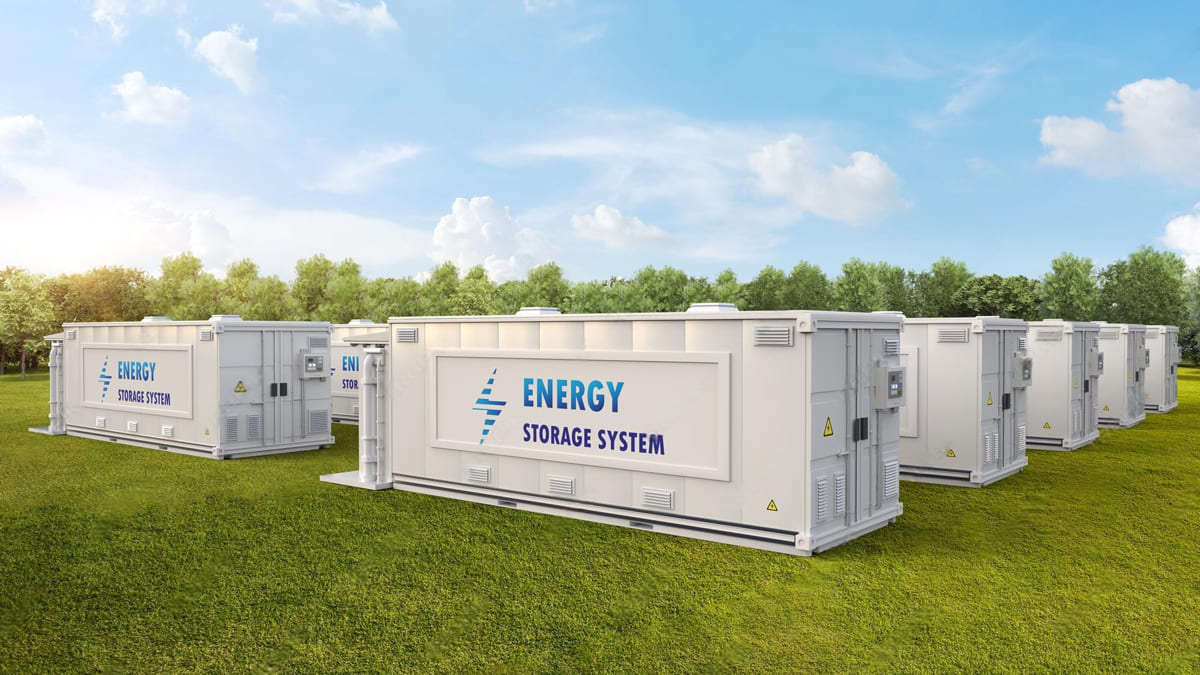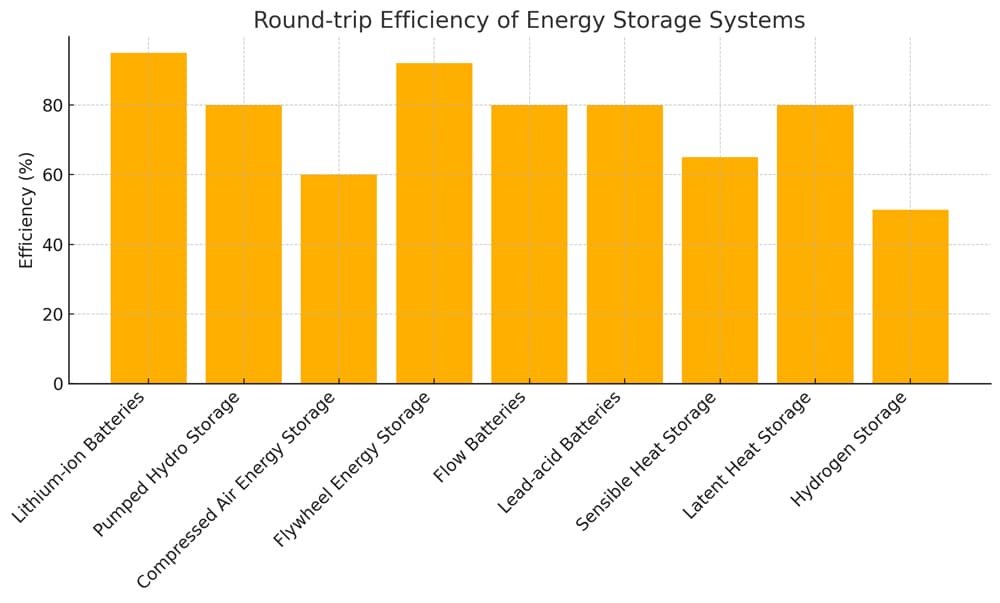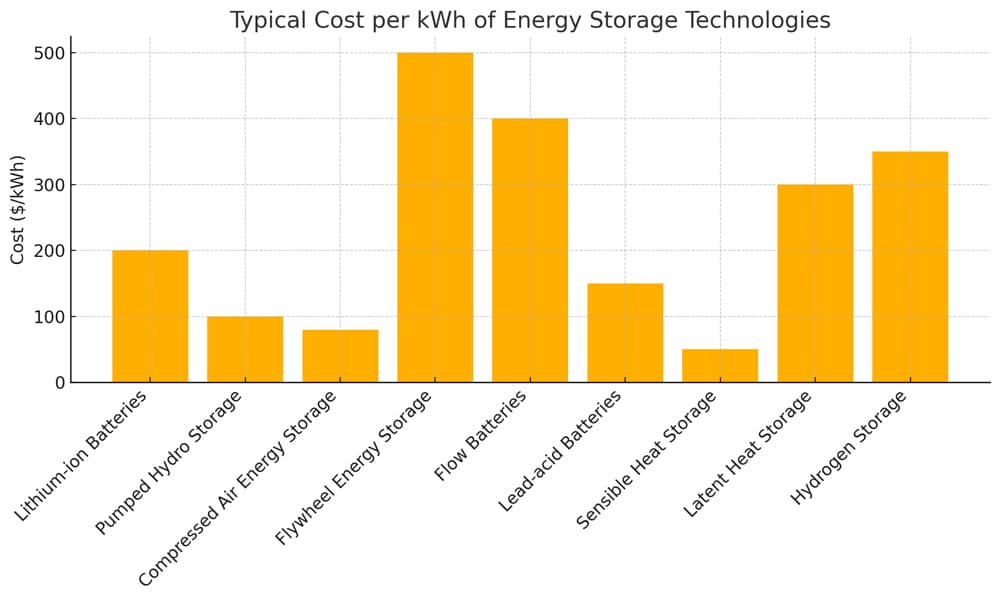Energy Storage System Definition
What is Energy Storage System?
An Energy Storage System (ESS) is a purpose‑engineered assembly of technologies, power electronics, control software and safety hardware that captures energy in one form—electrical, mechanical, thermal or chemical—stores it in a stable medium, and later reconverts it into grid‑compatible electricity or other usable energy streams on demand. From an industry‑expert perspective, an ESS is not simply a “battery,” but rather a fully integrated solution designed to optimize system performance, extend asset life, and monetize multiple value streams.
The rapid shift to renewable energy is exciting, but it also brings unpredictability. The sun doesn’t always shine, and the wind doesn’t always blow. This is where ESS steps in. It acts like a sponge, absorbing excess power when it’s abundant and releasing it when it’s needed the most.
Think of it like a bank account for energy—you deposit when you have more than enough, and withdraw when there’s a shortage. This flexibility is not just smart; it’s essential in a world transitioning to sustainable power.

Strategic Importance of Energy Storage System ESS in Modern Power Infrastructure
Grid Stabilization: Mitigates the intermittency of solar PV and wind farms.
Peak Demand Management: Shaves commercial and industrial energy costs by shifting load.
Resilience & Backup: Safeguards critical facilities—data centers, hospitals, manufacturing plants—against blackouts.
Revenue Optimization: Unlocks ancillary services markets (frequency regulation, demand response).
Sustainability Leadership: Supports ESG goals through reduced carbon footprints and improved energy efficiency.
Different Types of Energy Storage System: A Taxonomy of Technologies
Mechanical Energy Storage
Flywheel Energy Storage:
Mechanism: Kinetic energy stored in a high‑speed rotor; instant dispatch via generator coupling.
Strengths: Millisecond response, > 100 k cycle life.
Constraints: Sub‑hour duration, elevated $/kWh.
Chemical Energy Storage
Hydrogen Energy Storage:
Mechanism: Electrolysis produces H₂, stored in tanks or salt caverns, reconverted via fuel cells or turbines.
Strengths: Seasonal storage, zero‑carbon fuel for heavy industries.
Constraints: 40–60 % efficiency, high infrastructure CAPEX.
Flow Batteries:
Mechanism: Liquid electrolytes circulate through a cell stack; energy capacity scales with tank volume.
Strengths: Independent power/energy scaling, > 10 000 cycles.
Constraints: Lower energy density, elevated initial investment.
Electrochemical Energy Storage
Lithium‑ion Batteries:
Metrics: 150–250 Wh/kg; 90–95 % efficiency; 3 000–6 000 cycles.
Applications: Residential PV storage, EV charging, commercial peak shaving.
Considerations: Thermal management, critical‑materials sourcing.
Lead‑acid Batteries:
Metrics: 30–50 Wh/kg; 70–85 % efficiency; 500–1 000 cycles.
Applications: UPS, off‑grid backup.
Considerations: Lower lifespan, bulkier footprint, cost‑effective CAPEX.
Thermal Energy Storage
Sensible Heat Storage:
Mechanism: Heats media (water, molten salt) for later steam generation or direct heating.
Applications: Concentrated Solar Power (CSP), district heating.
Efficiency: 50–70 %.
Latent Heat Storage:
Mechanism: Phase‑change materials (PCMs) absorb/release heat at constant temperature.
Applications: Building HVAC, industrial process heat.
Strengths: High energy density, compact design.

Energy Storage System Application Scenarios
1. Grid Stabilization and Peak Shaving
Modern power systems operate under constantly fluctuating loads. Grid-connected energy storage systems are increasingly used to:
Mitigate Peak Demand: By storing energy during off-peak periods and discharging during high-demand intervals, ESS, including peak shaving battery storage solutions, help utilities avoid the high costs associated with peak power generation.
Provide Frequency Regulation: Rapid response from ESS units helps maintain grid frequency stability by smoothing out sudden surges or drops in load.
Support Voltage Stability: Strategic placement of ESS supports voltage regulation, ensuring that power quality remains within acceptable limits across the network.
This application is critical in reducing the strain on existing grid infrastructure while lowering operational costs and enhancing overall reliability.
2. Renewable Energy Integration
The intermittent nature of renewable energy sources like wind and solar requires robust solutions to ensure a continuous power supply. ESS are deployed to:
Capture Excess Generation: During times when renewable output exceeds demand, ESS store the surplus energy that can later be dispatched during periods of low production.
Enable Time-Shifting: By shifting the availability of energy from off-peak hours to peak consumption periods, ESS maximize the utility and economic efficiency of renewable installations while helping control energy costs.
Facilitate Hybrid Solutions: Integrating different ESS technologies—for example, pairing lithium-ion batteries with pumped hydro or flow batteries—creates a flexible system that optimizes the use of variable renewable resources.
This scenario enhances renewable penetration, ensuring that clean energy contributes reliably to the grid.
3. Commercial and Industrial Applications
In business and industrial environments, energy reliability is paramount for maintaining uninterrupted operations. ESS in these settings are utilized to:
Optimize Energy Management: On-site ESS, such as energy storage for office buildings, provide local load balancing, reducing dependency on grid-supplied power during outages or voltage fluctuations.
Lower Energy Costs: By reducing demand charges and enabling energy arbitrage—referred to as demand charge reduction storage—ESS store low-cost off-peak energy for high-cost peak consumption, directly lowering utility bills.
Enhance Uninterruptible Power Supply (UPS) Systems: Critical facilities, including data centers, manufacturing plants, and hospitals, integrate ESS to ensure that essential operations continue without interruption.
These applications enable commercial and industrial sectors to manage costs while boosting system resilience and operational efficiency.
4. Microgrids and Remote Electrification
For areas with unreliable or non-existent centralized grid infrastructure, ESS are fundamental in establishing microgrids that offer self-reliant power solutions. In this context, providers often offer industrial microgrid solutions that:
Remote Power Supply: ESS combined with local generation (such as solar panels or small wind turbines) provide stable and continuous power to remote communities, critical facilities, and off-grid industrial sites.
Disaster Resilience: In regions prone to natural disasters, microgrid systems with integrated ESS ensure that vital services such as healthcare, water supply, and communication remain functional, even during extended grid disruptions.
Community Energy Solutions: Modular ESS solutions enable scalable microgrids, allowing communities to incrementally expand their power systems according to demand and resource availability.
By providing energy independence, ESS deployments in microgrids enhance local resilience and improve overall quality of life in remote areas.
5. Electric Vehicle (EV) Charging Infrastructure
The expansion of the EV market is driving the need for robust charging infrastructure. ESS are integral to:
Managing High-Demand Loads: At fast-charging stations, ESS mitigate the peaks in power draw, preventing overloads on local distribution networks and reducing energy costs.
Optimizing Charging Cycles: Through energy arbitrage—charging during off-peak, low-tariff periods and discharging during peak times—ESS enhance the economic viability of EV charging stations.
Vehicle-to-Grid (V2G) Integration: Emerging V2G systems use the aggregated battery capacity of electric vehicles as dynamic ESS, feeding power back to the grid during peak demand and absorbing excess energy during off-peak hours.
This application not only supports the growing mobility sector but also facilitates broader grid modernization and renewable integration efforts.
6. Telecommunications and Data Center Backup
For critical infrastructure, uninterrupted power is crucial. ESS are deployed in telecommunications networks and data centers to:
Provide Reliable Backup: ESS offer seamless transition during power outages, ensuring minimal downtime and safeguarding data integrity.
Enhance Power Quality: By regulating supply during transient voltage fluctuations, ESS protect sensitive equipment from damage and performance degradation.
Reduce Dependence on Fossil Fuel Generators: Modern ESS reduce reliance on traditional diesel generators, lowering both operational costs and environmental impacts.
These backup and stabilization applications are essential for maintaining the continuous operation of systems critical to modern communications and information technology.
Energy Storage System Components
| Component | Function |
| Energy Storage Battery | High‑density cells (Li‑ion, flow) that store electrical energy |
| Battery Management System | Monitors cell health, balances SOC, enforces safety protocols |
| Power Conversion System (PCS) | AC/DC inversion and grid interface |
| Thermal Management System | Maintains optimal cell temperatures for performance and safety |
| Enclosure / Cabinet | Protective housing (e.g., Cytech’s robust cabinets) |
Evaluating Energy Storage System Cost
Critical Cost Drivers
Chemistry & Cell Quality: Premium Li‑ion vs. commodity lead‑acid.
Capacity & Duration: kW vs. kWh requirements scale CAPEX.
Balance‑of‑System (BoS): Inverters, controls, wiring, installation labor.
O&M & Warranties: Lifecycle service agreements and degradation profiles.
Site Preparation: Civil works, permitting, interconnection fees.

ROI & Cost‑Benefit Analysis for Businesses & Utilities
Peak Shaving Savings: 10–30 % reduction in demand charges.
Outage Cost Avoidance: Prevents revenue losses and reputational damage.
Ancillary Revenue: $10–20/kW‑mo from frequency regulation and spinning reserves.
ESG Impact: Demonstrable carbon reduction and improved sustainability ratings.
Pro Tip: Leverage Cytech’s energy storage system cost modeling tools to forecast TCO and ROI for your specific energy storage system application.
Why Cytech Sets the Benchmark in Energy Storage Solutions
Cytech stands at the forefront of the energy storage systems industry by delivering innovative, reliable, and scalable solutions that meet today’s evolving energy demands. As a leader among energy storage system companies, Cytech combines cutting-edge technology with industry-leading safety and compliance to deliver tailored solutions for diverse industrial applications.
Bespoke Engineering Solutions for Energy Storage
Cytech’s expertise lies in creating customized energy storage solutions designed for various industries. Their product offerings include:
These solutions offer flexibility and scalability, ensuring that installations are uniquely tailored to meet specific client needs.
Unmatched Safety and Global Compliance
Safety is a critical priority in the energy storage sector. Cytech’s systems feature:
Advanced Fire Suppression Technology: Reducing fire risks and enhancing system safety.
Comprehensive Diagnostic Tools: Monitoring system performance and health in real time.
UL/IEC Certifications: Guaranteeing that all products adhere to the highest global standards for safety and performance.
By prioritizing safety, Cytech ensures reliable, risk-mitigated operations, giving clients the confidence to deploy their systems in critical environments.
Modular Scalability and Smart Grid Integration
Designed for future growth, Cytech’s solutions offer modular scalability, which allows for easy capacity expansion without disrupting existing infrastructure. Key benefits include:
Seamless Capacity Expansion: Adapt and grow your energy storage capacity as energy needs increase.
Smart Grid Compatibility: Integration with smart grids enhances control, efficiency, and overall energy management.
This scalable design makes Cytech an ideal partner for organizations undergoing energy transitions, enabling both commercial and industrial clients to modernize their energy infrastructure seamlessly.
End-to-End Energy Storage Services
Cytech’s commitment extends beyond product innovation to comprehensive, end-to-end services. These include:
Site Assessment and Custom Design: Tailored system designs that address unique load and capacity requirements.
Professional Installation and Commissioning: Expert teams ensure a smooth transition from design to operational status.
24/7 Support and Proactive Maintenance: Continuous monitoring and maintenance to ensure long-term, optimal system performance.
This holistic service approach guarantees that clients receive complete support throughout the entire system lifecycle, maximizing performance and reliability.
Cytech: A Strategic Partner for Energy Transition
Positioned as a strategic partner for both commercial and industrial energy storage systems, Cytech helps businesses optimize their energy usage and enhance operational efficiency. Their tailored solutions support:
Energy Efficiency Improvements: Through demand response and peak shaving features, clients can reduce energy consumption during peak hours.
Sustainable Urban Grid Modernization: Smart grid integration ensures energy systems remain robust and efficient, while lowering operational costs.
Targeted Industrial Solutions: As an energy storage system company, Cytech provides customized solutions that meet the precise energy demands of manufacturing plants, commercial buildings, and critical infrastructure.
Innovative Battery Technologies and Proven Deployments
Cytech’s innovations in advanced battery technologies further cement its leadership:
Proprietary Battery Systems: Equipped with intelligent thermal management and integrated safety features for superior performance.
Low Total Cost of Ownership: Delivering reliable, long-lasting energy storage with optimized maintenance and operational costs.
Real-world projects validate Cytech’s approach:
Southeast Asia Commercial Microgrid: Deployment of modular outdoor battery enclosures led to a 70% reduction in diesel usage, promoting sustainable energy practices.
European Data Center: Integration of solar inverters and advanced ESS optimized energy consumption, yielding significant cost savings and emissions reductions.
How to Choose the Right Energy Storage System (ESS)
1. Assess Your Energy Needs
Capacity Requirements
Power Rating
Cycle Life
2. Analyze Your Load Profile
3. Consider Site Constraints & Environmental Factors
Footprint & Installation
Indoor vs. outdoor enclosures; retrofit vs. greenfield sites.
Space planning, ventilation, and fire‑safety clearances.
Ambient Conditions
Regulatory Compliance
4. Evaluate Budget vs. Lifecycle Value
CAPEX vs. OPEX Trade‑Offs
Total Cost of Ownership (TCO)
Return on Investment (ROI)
5. Ensure Safety, Monitoring & Security
6. Plan for Scalability & Renewable Integration
Modular Design
Renewables Compatibility
EV Charging Support
7. Leverage Cytech’s Customization & Expertise
Tailored Solutions
Software Flexibility
End‑to‑End Consultation
Ready to Optimize Your Energy Storage?
Contact Cytech today for a free consultation and get a fully customized ESS that delivers maximum performance, lowest cost, and future‑proof scalability.
Conclusion
As the world shifts toward cleaner, smarter energy solutions, Energy Storage Systems are no longer optional—they are essential. They provide the bridge between intermittent renewable energy and a stable, reliable power supply. For commercial and industrial users, they unlock opportunities for cost savings, operational continuity, and environmental stewardship.
Cytech has positioned itself as a global leader in this transformative space, offering scalable, intelligent, and rugged storage solutions tailored for real-world demands. From the robust Commercial and Industrial Energy Storage System to the sleek Energy Storage Cabinet, weather-resistant Outdoor Battery Enclosure, and reliable Energy Storage Battery, their products are powering a more resilient, sustainable future.
Whether you're a business owner looking to cut energy costs or a facility manager focused on sustainability, now is the time to consider integrating energy storage into your operations. With innovation-driven companies like Cytech leading the charge, the path to energy independence and resilience has never been clearer.
FAQs
1. What is the most efficient type of energy storage system?
Lithium‑ion batteries deliver up to 95 % round‑trip efficiency.
2. What industries benefit the most from energy storage systems?
Industries with high energy usage, such as manufacturing, logistics, healthcare, and data centers, benefit the most. These systems reduce operational costs, enhance grid independence, and provide backup during outages.
3. How long do energy storage batteries last?
High‑quality Li‑ion systems typically achieve 10–15 years or 3 000–6 000 cycles.
4. Are energy storage systems safe?
Yes—modern ESS incorporate BMS, thermal controls, and fire suppression to ensure robust safety.
5. What role does energy storage play in renewable energy?
ESS buffers the variability of solar and wind by storing surplus generation and dispatching it when needed.
6. How does Cytech support the energy transition?
By delivering scalable, customizable ESS solutions—complete with Energy Storage Cabinet, Outdoor Battery Enclosure, and Energy Storage Battery modules—Cytech empowers commercial and industrial clients to decarbonize, reduce costs, and enhance resilience.





















